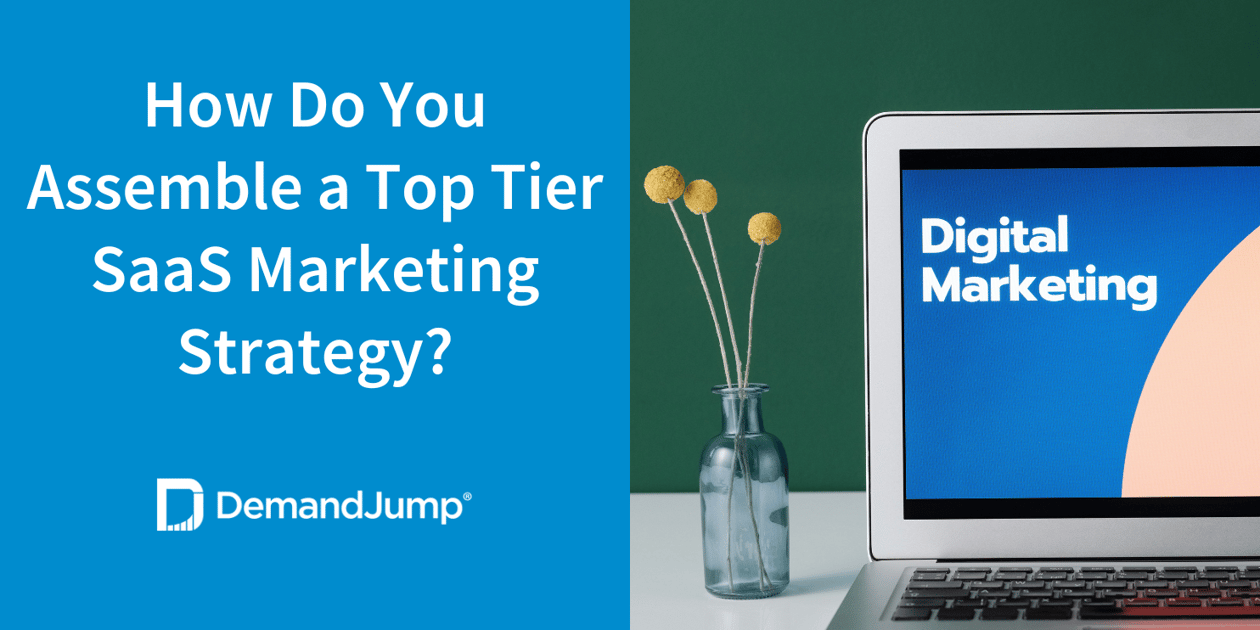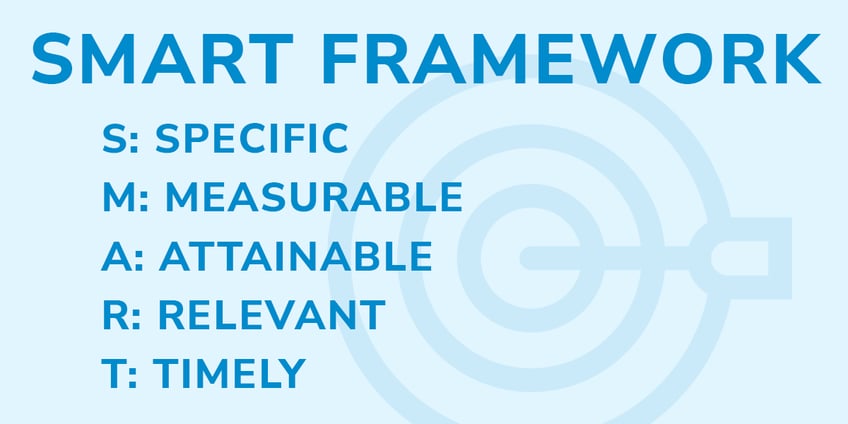How Do You Assemble a Top Tier SaaS Marketing Strategy?
November 2, 2022 •Josh Daugherty

If you’re part of a software-as-a-service (SaaS) marketing team, then you know the importance of identifying the right strategies to attract, engage, and convert prospects into loyal customers.
There are a few key differences between SaaS marketing and other types of marketing. First, the sales cycle is often, though not always, shorter for SaaS companies. It’s crucial that companies develop strategies that efficiently move the prospect through each stage of the SaaS buyer’s journey—awareness, consideration, and purchase.
In this blog, we’re going to outline the main components of SaaS marketing, some best practices for effective strategizing, and a SaaS marketing strategy example that should connect all the dots.
How Do You Develop a SaaS Marketing Strategy?
Developing a digital marketing strategy for your SaaS company consists of three main steps:
- Determining your strategic goals/objectives.
- Identifying the right marketing mix to attract, engage, and convert prospects.
- Putting it all together and implementing your strategy.
Step #1: Determine Your Goals
Any strategy—marketing or otherwise—should start with clear and meaningful objectives. By setting effective goals, identifying the right marketing channels to use—and understanding their impact—becomes easier.
We recommend using the SMART framework when setting your B2B SaaS marketing goals, meaning they are:

- Specific enough that everyone knows what you’re trying to achieve, with desired outcomes stated clearly.
- Measurable, with specific criteria identified and aligned with key performance indicators (KPIs) or other metrics that provide insight into how well the strategy is progressing.
- Attainable or achievable, with appropriately-ambitious goals—neither too easy nor too difficult.
- Relevant to the business objectives and your ideal customers’ pain points or other motivations for buying.
- Timely enough that the strategy, if well-implemented and ultimately delivered on, will meet or exceed the specific, measurable objectives. Think both short- and long-term.
Pro Tip: Align Your Goals with the Buyer’s Journey
For a well-rounded approach, it’s also important to strategize for each stage of the SaaS buyer’s journey, too:
- In the Awareness stage, prospects know they have a problem and begin searching for potential solutions. Ideally, they will learn about your company’s solution within the awareness stage, at which point they officially enter your marketing funnel.
- Next, they enter the Consideration stage and begin researching potential solutions for their most-compelling pain points and business needs. They’re comparing features and benefits, trying to narrow down their options.
- Finally, prospects reach the Purchase stage. After doing their research, they decide on a solution—yours, we hope—and become customers.
When you understand your customers’ journey(s) well, you can develop stage-specific strategies to increase brand awareness, influence prospects in their decision-making, and ultimately convert prospects into happy customers.
It’s worth noting that the SaaS buyer’s journey doesn’t end when they become a customer. Since SaaS companies are usually subscription-based, marketers have to develop strategies for continuing to deliver value in order to retain customers and prevent churn.
Step #2: Identify the Best Inbound & Outbound Channels to Use
How do you attract customers to SaaS? Effective SaaS marketers use a mix of outbound and inbound marketing channels and strategies to connect with a wide range of prospective customers. We’ll define each of these, with examples, below.
Outbound Marketing Channels
Outbound marketing channels are proactive efforts, reaching out to customers who might have a need for what you’re selling. Outbound marketing channel examples include print and/or digital ads; direct mail and/or email campaigns; cold calls; billboards and more.
Outbound marketing channels are all about ROI. Take, for example, pay-per-click (PPC) advertising. Developing a successful PPC advertisement campaign can help impact where you appear on search engine result pages (SERPs), increasing brand awareness and bringing prospects into the funnel.
Inbound Marketing Channels
Inbound marketing channels help SaaS companies to catch the organic attention of their ideal customers when they’re researching one or more pain points and evaluating potential solutions. With well over half (63%) of modern customers starting their buyer’s journey online, inbound marketing plays a pivotal role in acquiring leads and nurturing them through the conversion stage.
The biggest inbound marketing channel example is content marketing. This refers to a collection of strategies designed to help companies to be one of the first solutions these customers consider. And when you know exactly what kind of information your customers are searching for, you can develop content that addresses their pain points in a compelling way.
Content marketing can be difficult to begin, though. How do you know what your customers need and what searches they are making? With DemandJump’s automated keyword research tools, you can easily see exactly what your ideal customers are searching for and where they are ultimately going for their answers. Then, you can develop website content and blog posts that will provide high-quality information and set your business up as an industry authority.
Step #3: Put It All Together
Here’s an example of what an effective B2B SaaS marketing strategy that aligns with the buyer’s journey might look like:
Awareness
To connect with customers and build brand awareness, you might start by developing a content marketing strategy. DemandJump’s unique Pillar-Based Marketing (PBM) approach empowers content marketers with the insights and guidance they need to create the network of content that will move your company closer to the top of search engine result pages.
At the same time, you could complement your content marketing plan with some outbound marketing strategies—like a targeted email campaign or digital ads on high-traffic websites where your ideal customers are likely to see them.
Consideration
For prospects in the consideration phase, you can further refine your content marketing strategies. Here, instead of searching for general solutions (e.g., “How do I generate SaaS leads?”), customers are trying to narrow down their options (e.g., “What is the best SaaS marketing platform?”). With that in mind, you can develop more targeted content, like product/feature comparisons or content that describes how your offering has helped customers like them to achieve positive outcomes.
Purchase (and Post-Purchase)
This is where the proverbial rubber meets the road. Including effective calls to action (CTAs) in your content can help move interested prospects to take a specific action—like signing up for a free trial or customized product demo.
Don’t forget that SaaS providers have to deliver ongoing value to their customers, so you’ll want to account for a few additional considerations. This might include providing product/service support resources or guides to getting the most out of your offering. The more effective you are in this stage, the more likely customers will be to renew their subscriptions when the time comes.
Developing a Top Tier SaaS Marketing Strategy in 3 Steps [Recap]
![Assemble a Top Tier SaaS Marketing Strategy [3 Steps]](https://www.demandjump.com/hs-fs/hubfs/Blog%20Images/How%20Do%20You%20Assemble%20a%20Top%20Tier%20SaaS%20Marketing%20Strategy/Assemble%20a%20Top%20Tier%20SaaS%20Marketing%20Strategy%20%5B3%20Steps%5D.png?width=1484&height=742&name=Assemble%20a%20Top%20Tier%20SaaS%20Marketing%20Strategy%20%5B3%20Steps%5D.png) Develop a Top-Tier SaaS Marketing Strategy with DemandJump
Develop a Top-Tier SaaS Marketing Strategy with DemandJump
DemandJump, the world’s first and only PBM platform, empowers SaaS marketers with the insights and tools they need to develop an effective strategy and implement it successfully. When you partner with DemandJump, you gain access to automated keyword research and content planning tools that make it easy to outline a SaaS marketing strategy to meet or exceed your expectations.
Featured Articles
Categories
- Attribution Tracking (13)
- Channel Optimization (11)
- Consumer Insights (68)
- Content Marketing (251)
- Data Science (8)
- Digital Marketing (6)
- Digital Transformation (26)
- Enterprise (10)
- Lead Generation (14)
- Market Intelligence (8)
- Marketing Analytics (39)
- Marketing Attribution (57)
- Marketing Management (153)
- Marketing Operations (86)
- Organic Search (222)
- Paid Search (52)
- Pillar-Based Marketing (63)
- Programmatic Advertising (9)
- SaaS Content (14)
- SaaS Marketing (29)
- Search Marketing (111)
- SEO Keyword Research (28)
- SEO Pillar (18)
- SEO Strategy (46)
- SMB (5)
- Website Content (12)


